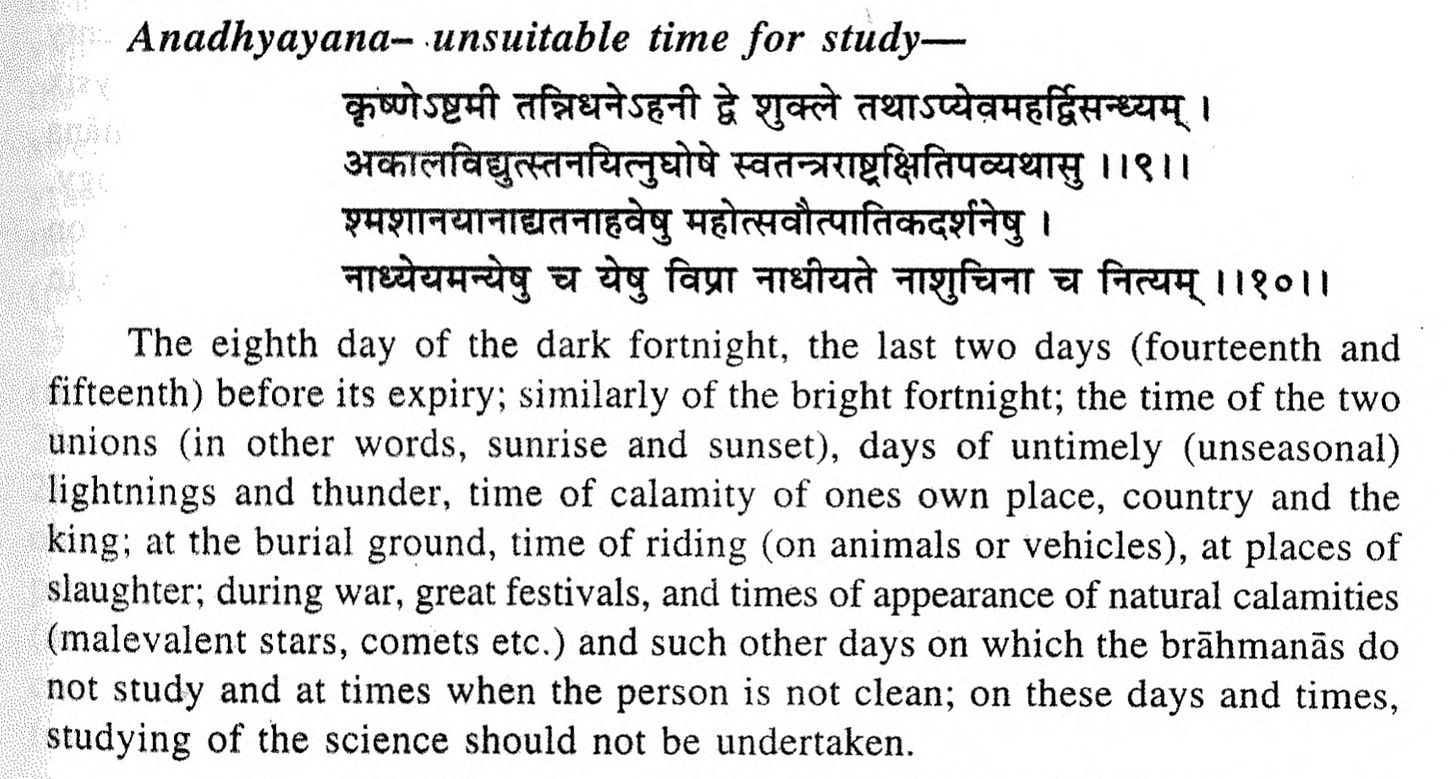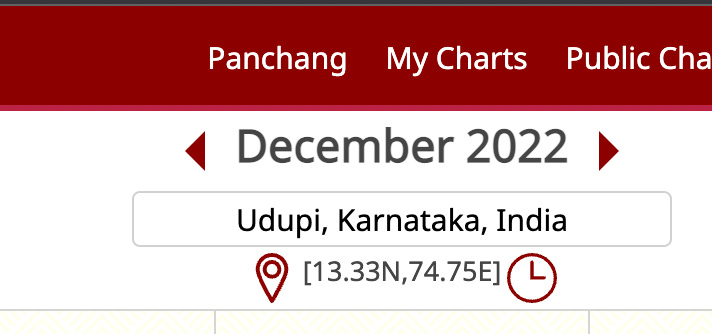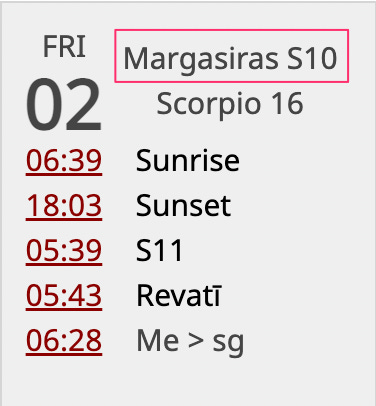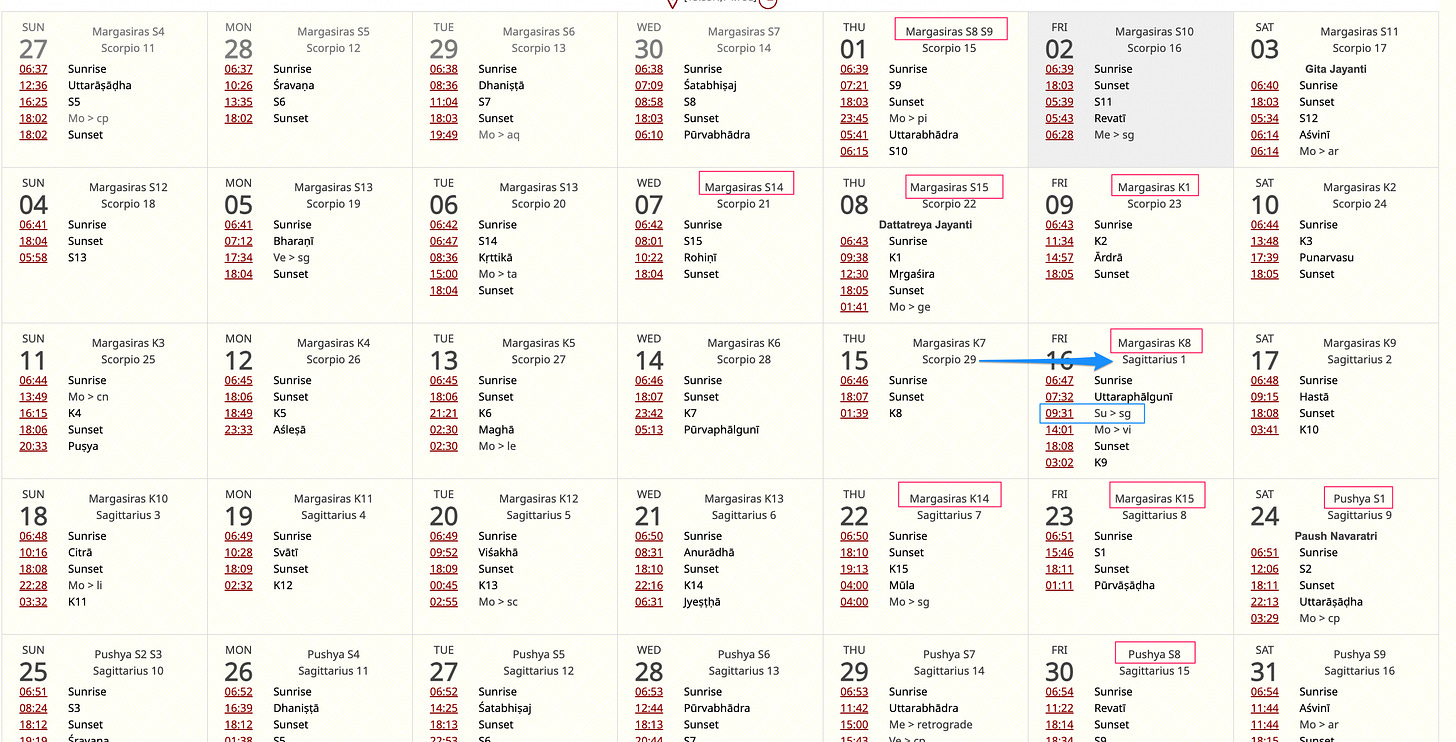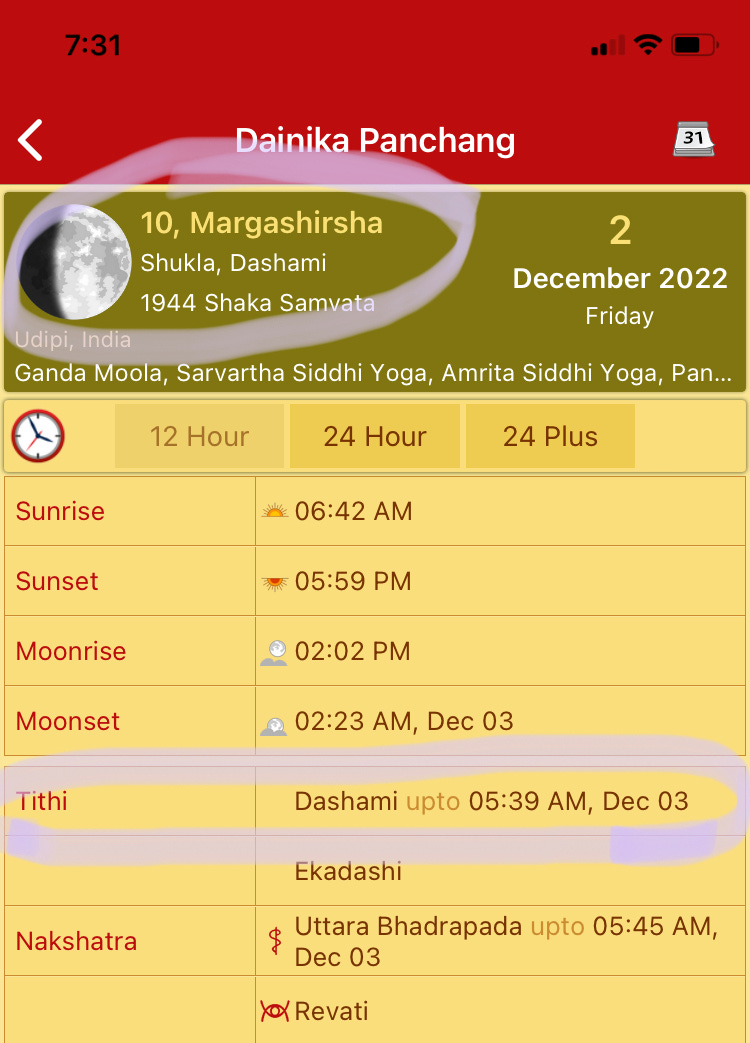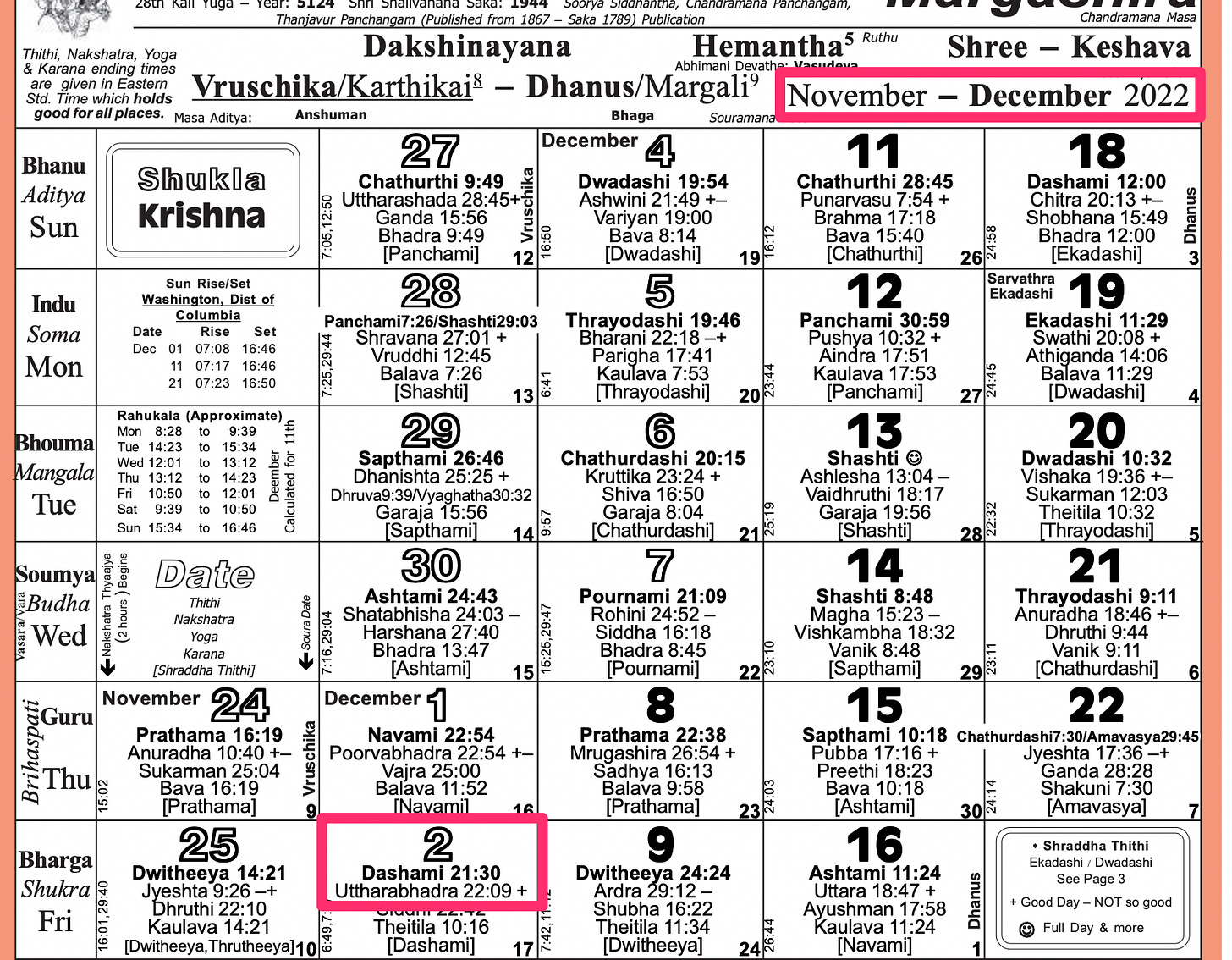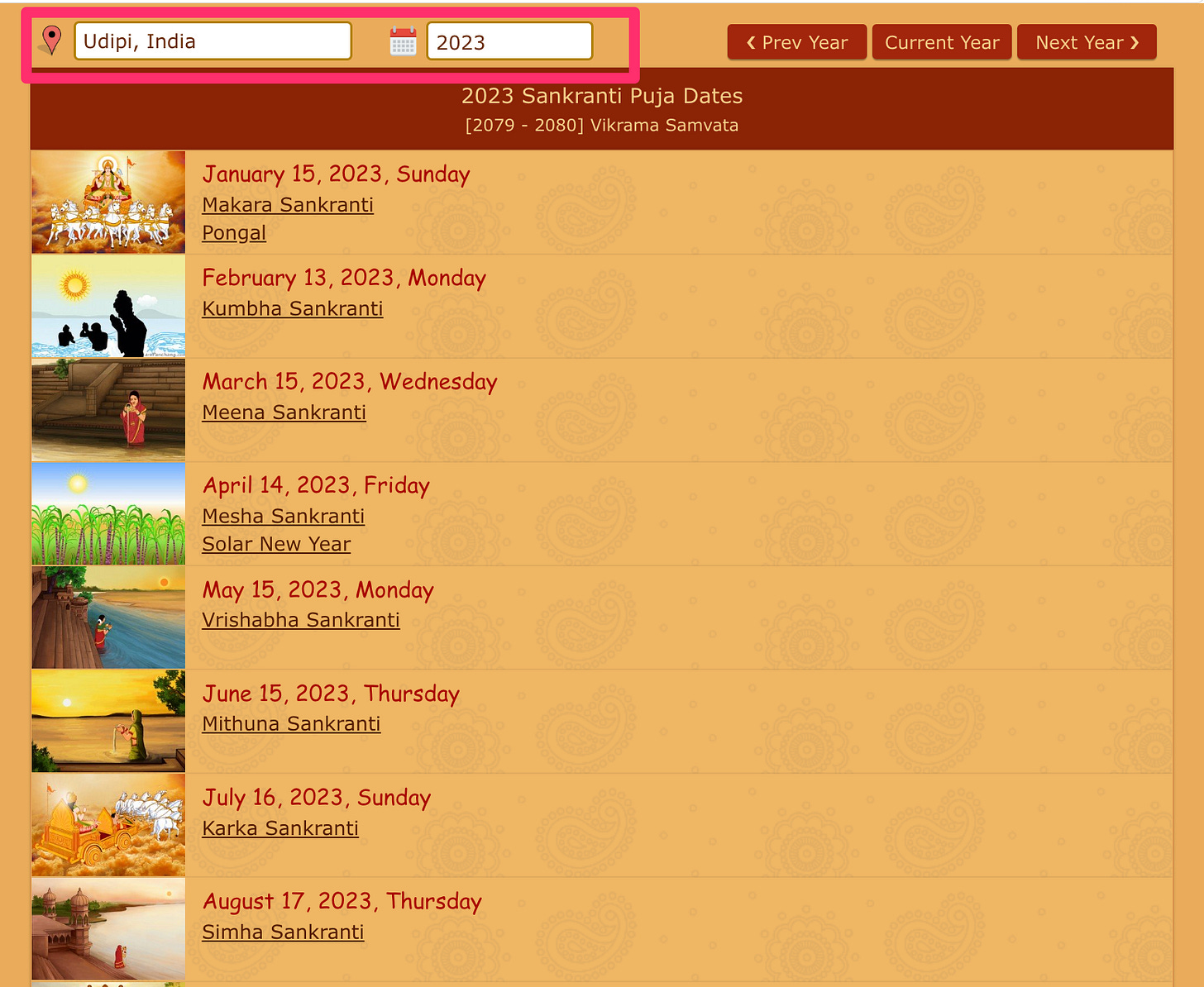How to Calculate Non-Study Days using the Panchanga
When studying the Vedas, it is important to consider the cycles of the moon to know when is the best day to study and when one should rest.
When reading Ayurvedic (and other Vedic) texts, there are certain days that the sages considered as inauspicious for study, called as Anadhyayana Days. According to Aṣṭāṅga Saṃgraha, Sūtrasthāna 2.4-5:

As the commentary says - it makes no sense to study during natural disasters, when survival is the most important task.
A more detailed list of non-study days is given in Suśruta Saṃhitā, Sūtrasthāna 2.9-10:
There is some ambiguity in this shlokas for those of us not as familiar with the Hindu practices. Specifically what exactly are “other days on which the Brāhmanās do not study” and what are the times when “the person is not clean”.
As I’m studying under Ayurveda Vaidya Dr. Satyajith Kadkol, I follow the list of days that he tells all his students to follow. Which include:
Pratipad - 1st
Aṣṭamī - 8th
Caturdaśī - 14th
Purṇimā - Full Moon
Amāvāsyā - New Moon
Days of Saṅkramaṇa - when the sun enters the next sign of the zodiac
For women - days of menstruation
These days are calculated based on the Panchanga, the Vedic Lunar Calendar system. I will write out how to look up these days in the Panchanga.
Choosing a Panchanga
First, there are many versions of Panchangas, all with their own schools of thought and variations. To keep it simple, I recommend one of the following choices:
The Udupi Krishna Matha Panchanga - this is the Panchanga that Dr. Satyajith follows. It is specific to the Udupi, India region (especially their new app). However, they have added versions for Washington DC, Chicago, LA, London, Dubai, and Sydney, which can be applied to other locations within these timezones.
Deva.guru - this is very nice online astrological software that comes highly recommended. It has some of its own “slang” codes that it uses, but is probably the easiest to use in general.
Divya Chakshu Android App - this app was recommended by our Medical Astrology teacher Mr. PR Selva Ganesh. Unfortunately, it is only on Android.
Drik Panchang - this is a very popular website / iPhone / Android app. I personally love their iPhone app for daily use.
All of the above will be used to calculate the Lunar days. For Saṅkramaṇa days (when the Sun enters the next Zodiac sign) I use the Drik Panchanga website here.
You can take a look at these resources and see which one resonates most with you.
The Process
My process, to keep things simple, is to spend a day once a year, when the New Year of Panchanga starts at the end of March / April and calculate the non-study days for the whole year, which I put into my Google Calendar. Then I don’t need to worry about it for a year.
But I also use the apps on a daily basis to look up specific astrological information and to get to know the Panchanga closer for my own practice.
In this blog post, I will only focus on the specific information to look for in calculating the non-study days specifically. I will use the Deva.guru Panchanga as that’ll be the simplest to open and follow along.
The Tithi
The Panchanga is a highly scientific calendar that follows the movement of the Moon as it relates to the sun. When the Moon and Sun are exactly opposite each other by 180 degrees, then we see it as the Full Moon or Purṇimā (this is a non-study day). As the Moon moves closer to the Sun each day, it is considered as Waning (becoming more black) until it cannot be seen, called Amāvāsyā or New Moon day (this is also a non-study day).
The moon is moving at approximately 12 degrees away or towards the sun each day, which is what is called a Tithi (a lunar day of approximately 24 hours).
As the moon is going from Amāvāsyā (New Moon) to Purṇimā (Full Moon), that is a 15-day period called Śukla Pakṣa - Śukla means White and Pakṣa means Part. In other words, it is the Waxing part of the month when the moon is becoming increasingly white.
Similarly, from Purṇimā to Amāvāsyā is a 15-day period called Kṛṣṇa Pakṣa - Kṛṣṇa means Black and Pakṣa means Part. It is the Waning part of the month when the Moon becomes more dark.
You can visualize it as follows as shown by Freedom Cole, a great Vedic Astrology teacher:
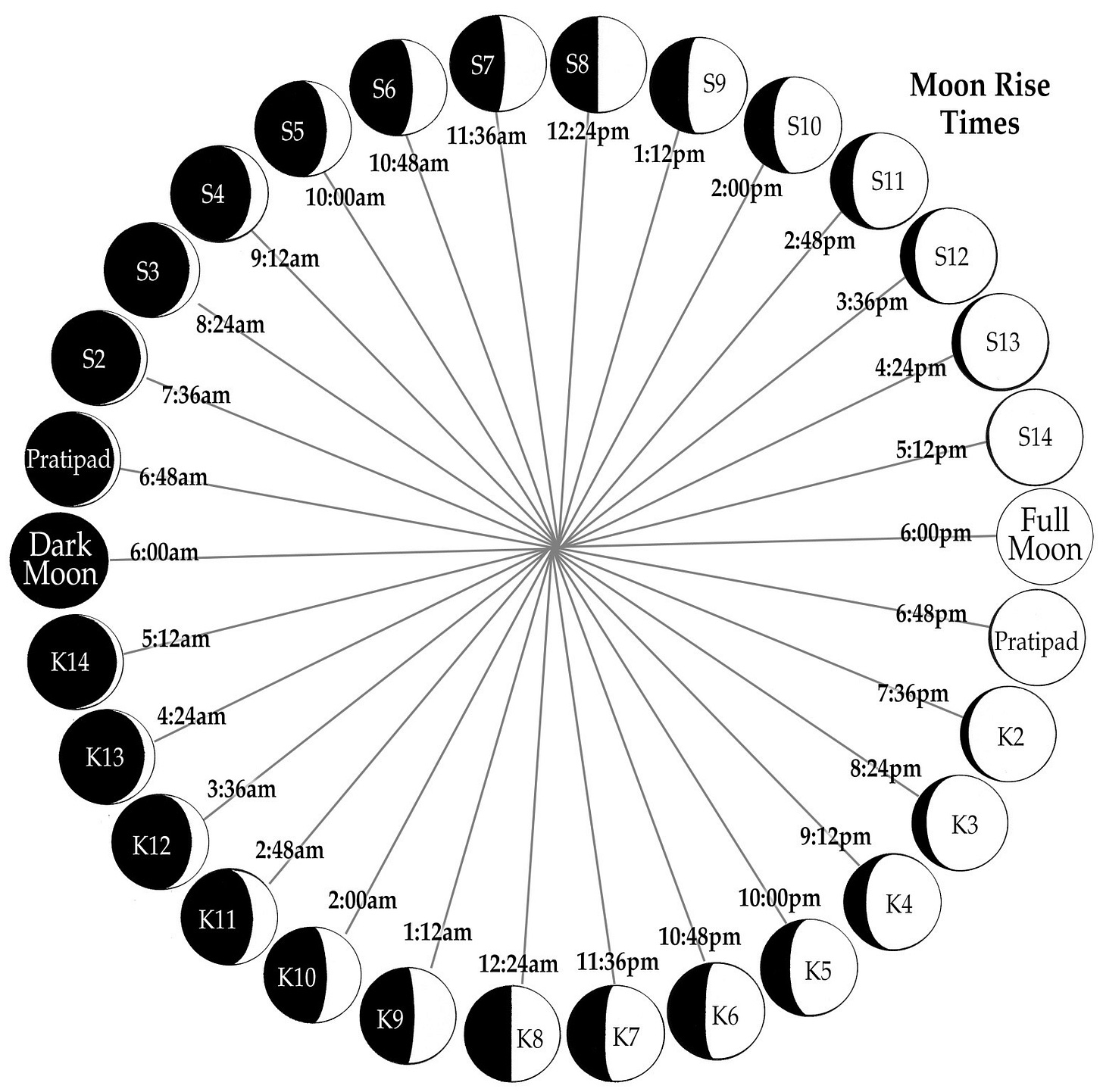
As you can see, the Days of the Śukla Pakṣa and Kṛṣṇa Pakṣa are counted from Pratipad (1st) to 14th, with the 15th day being either Purṇimā or Amāvāsyā.
The Non-study Days are
Pratipad - 1st (the first day after Purṇimā or Amāvāsyā)
Aṣṭamī - 8th (half-way point of Śukla Pakṣa or Kṛṣṇa Pakṣa)
Caturdaśī - 14th (the day before Purṇimā or Amāvāsyā)
Purṇimā - Full Moon
Amāvāsyā - New Moon
Calculating Non-Study Days
Going to Deva.guru Panchang, you would first select your location:
I will use Udupi, India as that is where I’m located.
Looking at today’s date, you will see the following information:
The Lunar month is Margasiras (following the Mrigashīrsha Nakshatra). The Tithi is S10. In other words, Śukla Pakṣa Day 10. This is a good day to study. To calculate the non-study days, I would be looking for S1, S8, S14, S15 (Purṇimā) and the same days for Kṛṣṇa Pakṣa - K1, K8, K14, K15 (Amāvāsyā).
The resulting non-study days for December would be as follows:
December 1st: Aṣṭamī -8th (S8). Note that S8 actually starts from 8:58am the day before, so you can count November 30th as a non-study day as well if you’re studying after the morning time.
December 7th: Caturdaśī - 14th (S14)
December 8th: Purṇimā (S15)
December 9th: Pratipad - 1st (K1)
Decmeber 16th: Aṣṭamī - 8th (K8). Note that if you look under the Lunar Calendar information “Mrgasiras K7” or “Mrgasiras K8”, you will see the Solar Calendar information. In this case, you can see that the Sun is switching from Scorpio to Sagittarius on this day as well. So this will also be a non-study day based on Saṅkramaṇa. While in December, the Lunar and Solar non-study days fall on the same day, this might not always be the case.
December 22nd: Caturdaśī - 14th (K14)
December 23rd: Amāvāsyā (K15)
December 24th: Pratipad - 1st (S1)
December 30th: Aṣṭamī -8th (S8)
And just to show a variety of examples across the Panchangas, the same information in the Drik Panchanga app would be under “Tithi” of the day.
And in the Krishna Matha Washington DC Panchanga, it looks as follows:
Days of Saṅkramaṇa
If it is too confusing how to find the Days of Saṅkramaṇa in the Deva.guru Panchanga, simply go to this page on the Drik Panchanga. Select your location and the year you’d like to look it up and mark the dates on your calendar!
Conclusion
I know it might be complicated at first, but the Panchanga is an incredible way to get connected to the lunar cycles of the month. I recommend starting with using it to calculate non-study days, but be open to exploring it a bit more to see what it offers. Next, look up Nakshatras each day (the cluster of stars that the Moon meets with) and read about them to get connected to the energies of the day!
Happy Learning!


